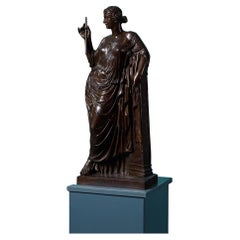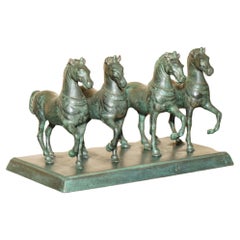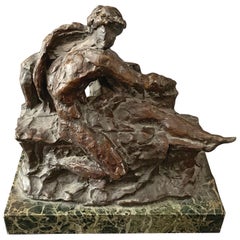René de Saint-Marceaux Decorative Objects
3
to
2
1
3
3
3
3
Height
to
Width
to
3
3
3
3
2
1,317
742
500
450
Creator: René de Saint-Marceaux
Harlequin by R. de Saint Marceaux, Cast by F. Barbedienne, France, Circa 1880
By F. Barbedienne Foundry, René de Saint-Marceaux
Located in PARIS, FR
Signature of René Saint-Marceaux and dated 1879
Signed F. Barbedienne Fondeur Paris
A. Collas Mechanical Reduction Stamps
Reduced Size: 3/5
Elegant statue of a standing Harlequin, ...
Category
1880s French Antique René de Saint-Marceaux Decorative Objects
Materials
Bronze
Bronze Statue of Arlequin by Charles-René de Paul de Saint-Marceaux
By René de Saint-Marceaux
Located in Los Angeles, CA
A Bronze Statuette of Arlequin by Charles-René de Paul de Saint-Marceaux.
Cast by Barbedienne.
The mischievous Harlequin, arms crossed in contemplation, wearing a grin and a mask, treading the boards of the stage, as befits his leading place in the Commedia dell'arte. Signed by the fondeur, Ferdinand Barbedienne, having the foundry cachet, and dated 1879, and the sculptor's name, St. Marceaux.
French, Circa 1880.
Paul de Saint-Marceaux (1845-1915) Son of a Reims wine merchant, entered the Ecole des Beaux-Arts de Paris under the tutelage of Jouffroy, exhibiting at the Salon of 1868, studying later in Italy. Considerable success followed, and he was awarded gold medals at the Paris Exposition Universelle of 1889, having been elected as a Chevalier to the Legion d'Honneur in 1880, and later becoming an officer. His public Parisian works may be seen in the Champs-Elysees (Alphonse Daudet the noted novelist) and Alexander Dumas...
Category
1870s French Antique René de Saint-Marceaux Decorative Objects
Materials
Bronze
Small Gilded French Bronze Bust by Rene de Saint-Marceaux, 1897
By Louchet Foundry, René de Saint-Marceaux
Located in Delft, NL
Small antique gilded French bronze bust by Rene de Saint-Marceaux
Named and marked E. Polo and dated 1897
This small gilded bronze is a bust of a child signed D. St. Rene for Ren...
Category
19th Century French Antique René de Saint-Marceaux Decorative Objects
Materials
Bronze
Related Items
F. Barbedienne Large Bronze Sculpture of Euterpe
By F. Barbedienne Foundry
Located in Wormelow, Herefordshire
A bronze sculpture of Euterpe attributed to French metalworker Ferdinand Barbedienne (1810-1892). Embellished to the reverse with the official stamp of the Collas et Barbedienne foun...
Category
Mid-19th Century French Neoclassical Antique René de Saint-Marceaux Decorative Objects
Materials
Bronze
HEAVY ANTIQUE SiGNED GRAND TOUR BRONZE STATUE OF THE FOUR HORSES OF SAINT MARKS
Located in GB
Royal House Antiques
Royal House Antiques is delighted to offer for sale this stunning original Circa 1880 hand made in Italy Grand Tour bronze of the Horses of Saint Marks
This i...
Category
1880s Italian Grand Tour Antique René de Saint-Marceaux Decorative Objects
Materials
Bronze
H 6.3 in W 10.24 in D 6.11 in
19th Century Bronze Figure of the Berlin Adorante by Barbedienne Foundry
By F. Barbedienne Foundry
Located in 263-0031, JP
A 19th-century patinated bronze figure of the Berlin Adorante, or Praying Boy. The piece is a reduction of the Hellenistic-era original, currently in t...
Category
19th Century French Neoclassical Antique René de Saint-Marceaux Decorative Objects
Materials
Bronze
H 22.45 in W 8.47 in D 8.27 in
Bronze Sculpture of the Artist Joseph Charles de Blezer.
Located in Saint-Ouen, FR
Bronze sculpture of the Artist Joseph Charles de Blezer.
Bronze sculpture from the 19th century, Napoleon III period by Joseph Charles de Blezer (1828-1884).
h: 49cm , w: 21cm, ...
Category
19th Century French Napoleon III Antique René de Saint-Marceaux Decorative Objects
Materials
Bronze
Gilded Bronze Bust of a Courtesan by Eugène Antoine François Aizelin.
By Eugene-Antoine Aizelin
Located in Saint-Ouen, FR
Gilded bronze bust of a courtesan by Eugène Antoine François Aizelin.
Bust of a courtesan by Eugène Antoine François Aizelin ( 1821-1902 ), 19th century, gilt bronze and marble base...
Category
19th Century French Napoleon III Antique René de Saint-Marceaux Decorative Objects
Materials
Marble, Bronze
‘Gloria Victis’, A Patinated Bronze Figural Group by Mercié, Cast by Barbedienne
By Ferdinand Barbedienne
Located in Brighton, West Sussex
A Patinated Bronze Figural Group of ‘Gloria Victis’ (‘Glory to the Vanquished’), Cast by Ferdinand Barbedienne from the Model by Marius-Jean-Antonin Mercié (French, 1845-1916).
‘Gloria Victis’ (‘Glory to the Vanquished’).
Bronze, gilt and dark brown patina.
Signed 'A. Mercié', with foundry inscription 'F. BARBEDIENNE, Fondeur. Paris.' and A. Collas reduction cachet. The integral base titled 'GLORIA VICTIS'.
This cast is part of a limited edition by the Barbedienne Foundry.
France. Circa 1880.
‘Gloria Victis’ is one of the most recognisable and important works of sculpture of the nineteenth century and a definitive image of France’s historic national identity. The figure of glory, winged and wearing armour, carries a dying young warrior heavenwards towards fame and immortality. The compositional daring of the group must be admired for balancing two figures on the minimal support of one foot, wings spread in the moment before taking flight.
Mercié was a student at the French Academy of Rome when the Prussians invaded France in 1870. Shortly after the war had begun, he executed a group depicting the figure of Fame supporting a victorious soldier. When news reached Mercié in Rome that the French had surrendered, he decided to alter his group, replacing the victorious soldier with a defeated casualty, thus transforming an allegory of ‘Glory to the Victors’ into one of ‘Glory to the Vanquished’. Completed in 1872, a year after the defeat of French soldiers against the Prussian army, the statue personifies a defeated but heroic France. The title is also a reversal of the famous formula, ‘Vae Victis’ (Death to the Vanquished), which the Gallic general Brennus exclaimed upon defeating the Romans in 390 BC. The figure of the fallen soldier was thought to represent Henri Regnault, a fellow sculptor of Mercié who was killed on the last day of fighting.
Measuring 317 cm. high the original group of ‘Gloria Victis’ was unveiled in plaster at the Salon of 1872. It was bought by the City of Paris for the sum of twelve thousand francs and then cast in bronze by Victor Thiébaut for eight thousand five hundred francs. The bronze was exhibited at the Salon in 1875 and first placed in Montholon Square in the 8th arrondissement. In 1884 it was transferred to the courtyard of the Hôtel de Ville and in 1930, it entered the collection of the Musée du Petit Palais, where it can be seen to this day.
The Thiébaut Frères foundry also cast Gloria Victis bronzes for the cities of Niort (requested 1881) Bordeaux (requested 1883), Châlons-sur-Marne (today, Châlons-en-Champagne; requested 1890), and Cholet (requested 1901). In 1905, the Danish brewer and art collector Carl Jacobsen was permitted to have an exact cast made of the original sculpture in Paris, on condition that the base was made 2 cm lower and bore the inscription “Original tilhører Paris By” (The original belongs to the City of Paris). It too was cast by the Thiébaut Frères foundry. Gloria Victis was one of Jacobsen’s most important and his last acquisition. Today it has been returned to its original position in the Winter Garden at Glyptoteket, Copenhagen, Denmark.
The full-size plaster was shown again at the Paris Expositon universelle of 1878 alongside a bronze reduction by Barbedienne. By this time Antonin Mercié had entered into a commercial edition contract with the Ferdinand Babedienne foundry to produce bronze reductions of Gloria Victis, his most famous work. Gloria Victis is first recorded to have been produced in three sizes and by 1886 Barbedienne’s ‘Catalogue des Bronzes D’Art’ lists six sizes measuring 3/5, 9/20, 7/20, 3/10, 6/25 and 2/10, of the original. These reductions were produced by an invention of Barbedienne’s business partner Achille Collas. The Collas reducing machine was a type of complex mechanical pantograph lathe that enabled sculpture to be mathematically measured and transcribed to scale, in the round, thus making a reduced size plaster from which a bronze could be cast.
Mercié's modern sculpture had become an instant classic, even receiving an entry in the Nouveau Larousse Illustré. The success of the group undoubtedly lay in the fact that it was admired not just on an aesthetic level, but also on a patriotic level, particularly in its commemoration of heroism in defeat. Immediately ‘Gloria Victis’ was recognised as a national artwork, capable of arousing patriotism and casts were ordered from Barbedienne as local memorials commemorating the war’s dead for cities across France. ‘Gloria Victis’ was considered so much a part of France’s national identity that for the 1900 Paris Exhibition, Ferdinand Barbedienne’s nephew Gustave Leblanc, loaned a bronze example to feature as part of l’Exposition centennale de l’art français.
Literature:
For an interesting account of the process of creating a reduction in bronze of the Gloria Victis by Barbedienne and illustrations of the casting and finishing of the bronze see:
'Ferdinand Barbedienne': Theodore Child; Harper's new monthly magazine, Volume 73, Issue 436, September 1886.
‘Contemporary French Sculptors’: The Century, Volume 33, Issue 3, Jan 1887.
‘Modern French Sculpture’: Harper's new monthly magazine, Volume 76, Issue 452,
January 1888.
S, Lami, ‘Dictionnaire des sculpteurs de l'Ecole française au dix-neuvième siècle’, Tome III. G.-M., Paris, 1914, p. 432.
Peter Fusco and H.W. Janson, The Romantics to Rodin: French Nineteenth Century Sculpture from North...
Category
19th Century French Antique René de Saint-Marceaux Decorative Objects
Materials
Bronze
H 41.74 in W 16.54 in D 14.18 in
French Bronze Sculpture "Tiger Walking" after Antoine-Louis Barye, Barbedienne
By F. Barbedienne Foundry, Antoine-Louis Barye
Located in Shippensburg, PA
ANTOINE-LOUIS BARYE
French, 1795-1875
"Tigre Qui Marche"
Dark brown patinated bronze Signed in base "A.L. BARYE", incised "F. BARBEDIENNE FONDEUR, PARIS", cold-stamped FRANCE cold-tooled to underside 19.691 conceived 1841, cast circa early 20th century
Item # 111GPP20Q
Barye's ability to merge our romantic idealization of nature with a colder reality of nature's predator is beautifully represented in this striding cat. Originally conceived in 1841, Tigre Qui Marche (Walking Tiger...
Category
Early 20th Century French Romantic René de Saint-Marceaux Decorative Objects
Materials
Bronze
H 5.512 in W 10.5 in D 2.63 in
19th Century Demosthenes Bronze Sculpture by Barbedienne Foundry
By F. Barbedienne Foundry
Located in 263-0031, JP
A bronze figure representing Demosthenes (384-322 BC), a Greek statesman and orator. The sculpture is based on a Roman copy of an original Greek statue. The chocolate-brown patina of...
Category
19th Century French Neoclassical Antique René de Saint-Marceaux Decorative Objects
Materials
Bronze
No Reserve
H 15.95 in W 5.91 in D 4.14 in
French 19th Century Gilded Bronze Dog Fremiet & Barbedienne
By F. Barbedienne Foundry, Emmanuel Fremiet
Located in Newark, England
Fine 19th century French gilded bronze model of a dog. The bronze beautifully cast by renowned French sculptor Emmanuel Frémiet. Cast as a recumberant Samoyed on an elongasted oval b...
Category
Late 19th Century French Napoleon III Antique René de Saint-Marceaux Decorative Objects
Materials
Bronze
Gilded Bronze Bust of Louise Brongniart by Houdon.
Located in Saint-Ouen, FR
Gilded bronze bust of Louise Brongniart by Houdon.
Sculpture of a bust of Louise Brongniart by Jean-Antoine Houdon (1741-1828), reproduction of the XIXth century.
h: 23cm , w: 1...
Category
19th Century French Louis XVI Antique René de Saint-Marceaux Decorative Objects
Materials
Bronze
Saint-Christophe, by Jules René Lalique
By René Lalique
Located in Paris, FR
Sculpture by René Lalique in sculpted glass
Signed
Category
Mid-20th Century French René de Saint-Marceaux Decorative Objects
Materials
Glass
Antique Bronze Statue of Arlequin by René de Saint-Marceaux
By Ferdinand Barbedienne
Located in London, GB
A bronze Statuette of Arlequin
by Charles-René de Paul de Saint-Marceaux
Cast by Barbedienne. The mischievous Harlequin, arms crossed in contemplation, wearing a grin and a mask, tr...
Category
1880s French Belle Époque Antique René de Saint-Marceaux Decorative Objects
Materials
Bronze
Previously Available Items
"Genius Keeping the Secret of the Tomb, " Study for Sculpture at Musee d'Orsay
By René de Saint-Marceaux
Located in Philadelphia, PA
This rough-hewn bronze study was made for a highly-important funerary sculpture -- Génie gardant les secrets de la tombe ("Genius Keeping the Secret of the Tomb") -- by renowned scul...
Category
1890s French Belle Époque Antique René de Saint-Marceaux Decorative Objects
Materials
Bronze
H 7.125 in W 7.25 in D 3.625 in
Harlequin by René de Saint-Marceaux / F. Barbedienne Foundry, Paris
By F. Barbedienne Foundry, René de Saint-Marceaux
Located in Dallas, TX
Bronze harlequin from the Barbedienne Foundry, Paris, from the original 1879 bronze sculpture by French sculptor René de Saint-Marceaux (1845-1915), Barbedienne mark (see Image 6)
...
Category
Late 19th Century French Beaux Arts Antique René de Saint-Marceaux Decorative Objects
Materials
Bronze
René De Saint-marceaux decorative objects for sale on 1stDibs.
René de Saint-Marceaux decorative objects are available for sale on 1stDibs. These distinctive items are frequently made of metal and are designed with extraordinary care. There are many options to choose from in our collection of René de Saint-Marceaux decorative objects, although gold editions of this piece are particularly popular. If you’re looking for additional options, many customers also consider decorative objects by Eugene-Antoine Aizelin, Ernestine Sirine-Real, and Henry Cahieux and Ferdinand Barbedienne. Prices for René de Saint-Marceaux decorative objects can differ depending upon size, time period and other attributes — on 1stDibs, these items begin at $1,420 and can go as high as $26,923, while a piece like these, on average, fetch $8,200.





